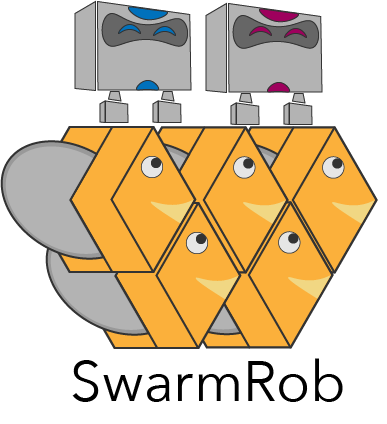Commands¶
Every command you can use starts with either swarmrob or swarmrob-worker. Which of the one you have to use depends on which version of SwarmRob you have installed. If you have installed the full version you have to use the command swarmrob and if you have the worker version installed you have to use swarmrob-worker. The examples on this page use the command swarmrob but work with both commands unless stated otherwise.
SwarmRob uses the three different subcommands master, worker and daemon to distinguish between the three different parts of the programm.
- swarmrob check
- There is also a fourth command that checks if all requirements have been installed correctly and installs them if they haven’t been installed already.
- Example:
>>> swarmrob check
- swarmrob help
- Note that with every command (including
swarmrob,master,workeranddaemon) you can always use the help command to get a list of all possible subcommands. - Parameters:
- -v [–verbose] : Every command has the
verboseparameter to print more detailed logs (optional)
- -v [–verbose] : Every command has the
- Example:
>>> swarmrob help >>> swarmrob master help >>> swarmrob worker help >>> swarmrob daemon help
master¶
To use the master commands you need to have the full version of SwarmRob installed. They are used to create and manage a swarm.
- swarmrob master init
- The
initcommand initializes a new swarm and nominates this node to be the master node of the swarm. Note that only one swarm can be created on one instance of the SwarmRob daemon. - Parameters:
- -a [–advertise_address] : IPv4-Address of the master node (optional)
- -i [–interface] : Interface the command uses to communicate with the daemon (optional)
- -u [–swarm_uuid] : UUID of the new swarm (optional)
- Example:
>>> swarmrob master init -u my_swarm
- swarmrob master list
- The
listcommand lists some information about the swarm. - Parameters:
- -i [–interface] : Interface the command uses to communicate with the daemon (optional)
- Example:
>>> swarmrob master list -i lo
- swarmrob master swarm_status
- The
swarm_statuscommand prints more informations about the swarm. - Parameters:
- -i [–interface] : Interface the command uses to communicate with the daemon (optional)
- Example:
>>> swarmrob master swarm_status -i lo
- swarmrob master worker_status
- The
worker_statuscommand prints more informations of a specific worker in the swarm. - Parameters:
- -u [–worker_uuid] : UUID of the worker
- -i [–interface] : Interface the command uses to communicate with the daemon (optional)
- Example:
>>> swarmrob master worker_status -u ab4f3466c1ed45b3bc78caa38b2ee489
- swarmrob master start_swarm
- The
start_swarmcommand executes an EDF and starts its described services on the workers. - Parameters:
- -u [–swarm_uuid] : UUID of the new swarm
- -c [–compose_file] : EDF that should be executed
- -i [–interface] : Interface the command uses to communicate with the daemon (optional)
- -l [–log_identifier] : Identification string to use for the log file (optional)
- -f [–log_folder] : Log folder to save the log in (optional)
- Example:
>>> swarmrob master start_swarm -u my_swarm -c my_edf.yaml
worker¶
The worker subcommand is used to handle all things related to the worker on the current system.
- swarmrob worker join
- The
joincommand lets you add a worker to a swarm. - Parameters:
- -u [–uuid] : UUID of the swarm that should be joined
- -i [–interface] : Interface the command uses to communicate with the daemon (optional)
- Example:
>>> swarmrob worker join -u my_swarm@127.0.0.1
- swarmrob worker leave
- The
leavecommand allows you to remove this worker from a swarm. Note that the worker will stop all services that have been running in this swarm. - Parameters:
- -u [–uuid] : UUID of the swarm that should be left
- -w [–worker_uuid] : UUID of the worker that should leave the swarm
- -i [–interface] : Interface the command uses to communicate with the daemon (optional)
- Example:
>>> swarmrob worker leave -u my_swarm@127.0.0.1 -w ab4f3466c1ed45b3bc78caa38b2ee489
- swarmrob worker status
- The
statuscommand prints some information about the current worker. - Parameters:
- -i [–interface] : Interface the command uses to communicate with the daemon (optional)
- Example:
>>> swarmrob worker info -i lo
daemon¶
The daemon makes sure that the current node can be reached by other nodes.
- swamrob daemon start
- The
startcommand starts the SwarmRob daemon. - Parameters:
- -i [–interface] : Interface the daemon should use to communicate (optional)
- Example:
>>> swarmrob daemon start -i lo
- swamrob daemon status
- The
statuscommand prints status informations about the SwarmRob daemon. - Parameters:
- -i [–interface] : Interface the command uses to communicate with the daemon (optional)
- Example:
>>> swarmrob daemon status -i lo
- swamrob daemon stop
- The
stopcommand stops the SwarmRob daemon. - Parameters:
- -i [–interface] : Interface the command uses to communicate with the daemon (optional)
- Example:
>>> swarmrob daemon start -i lo
- swamrob daemon check
- The
checkcommand checks if docker is running successfully.
Parameters: (None)
- Example:
>>> swarmrob daemon check
